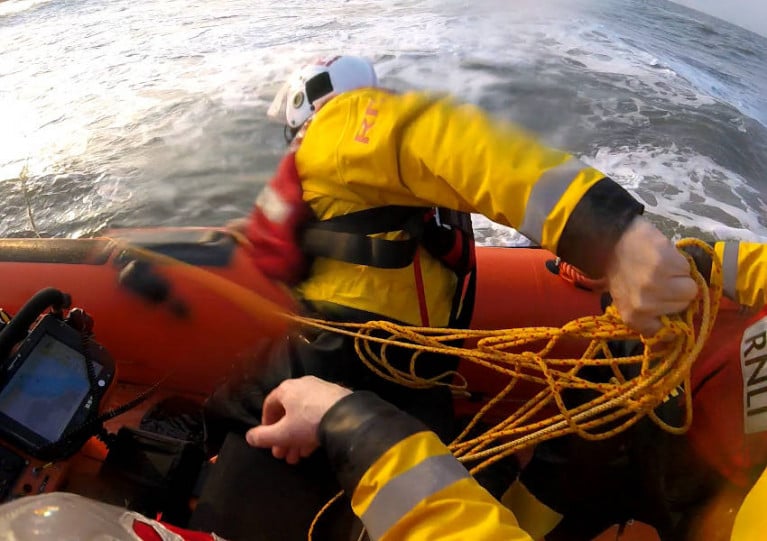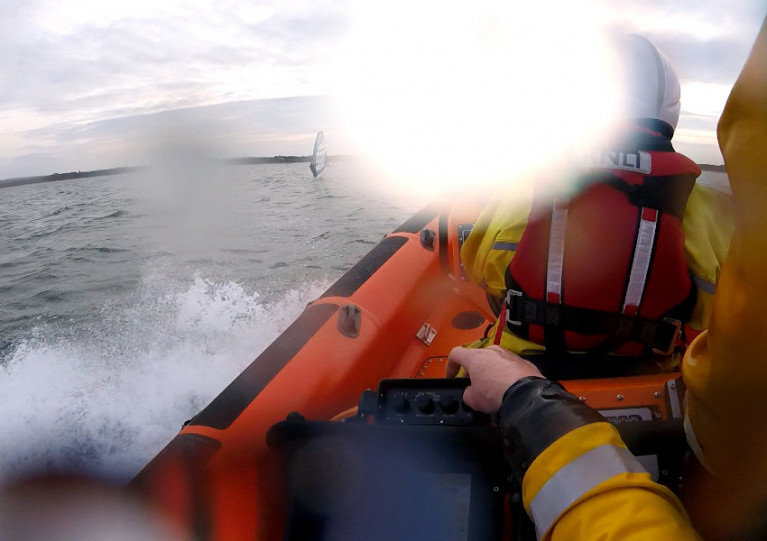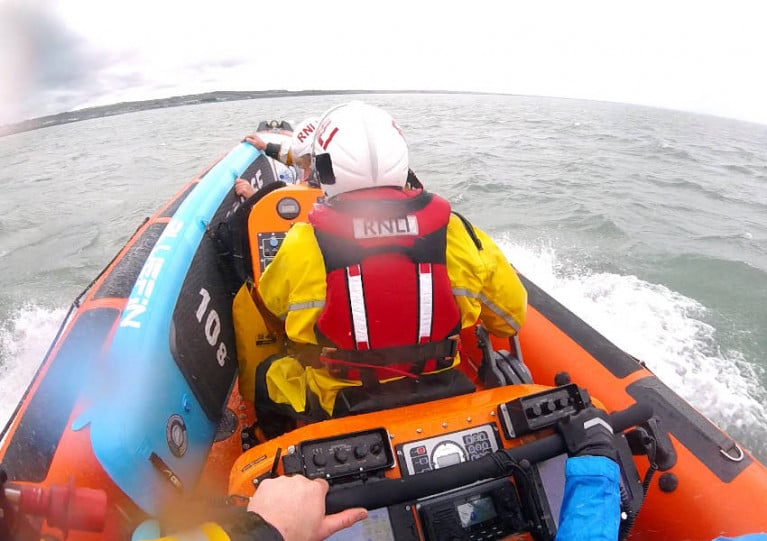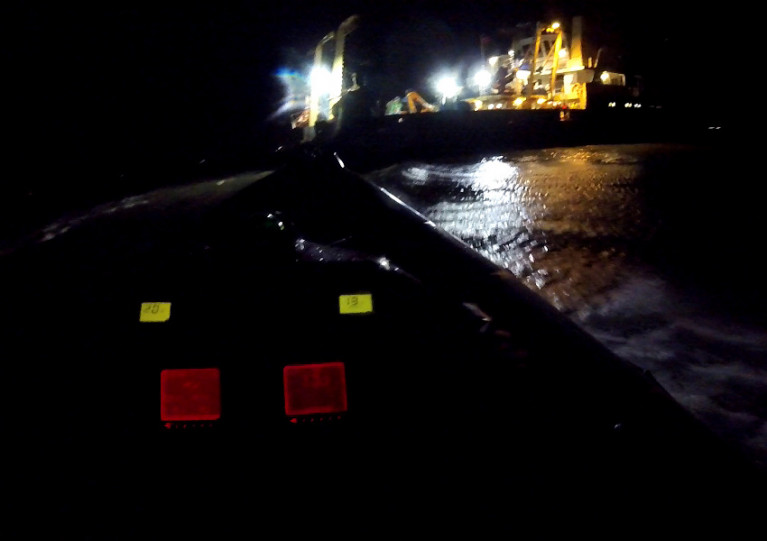Displaying items by tag: Skerries
Skerries & Howth Lifeboats Launch to Sinking Vessel Off Rush
RNLI volunteers from Skerries and Howth were tasked to Rush in north Co Dublin on Wednesday afternoon (4 August) following a Pan-Pan VHF call from small fishing boat with two on board that was taking on water near the entrance to Rogerstown Estuary.
With the possibility of persons entering the water, both lifeboats launched shortly after 4.30pm and headed for Rogerstown at the maximum possible safe speed amid moderate conditions, with a Force 4 wind.
As the inshore lifeboat from Skerries arrived on scene, they could see that the casualty vessel had sunk on the bar at the entrance to Rogerstown Estuary.
There were people in the water in the vicinity of the boat where it was grounded, however the water was shallow enough for them to stand.
As lifeboat volunteers assessed the situation, Howth RNLI’s all-weather lifeboat arrived and stood by in case of needed assistance. A ground unit from Skerries Coast Guard was also in attendance.
It was quickly established that the two people from the boat had made it to safety on the beach, but then re-entered the water trying to lay out an anchor to secure the boat.
With the aid of the Skerries RNLI crew, they managed to turn the boat to bring the bow into the waves, which enabled them to bail the boat out and refloat it.
Noting the large number of windsurfers and kitesurfers in the area, Skerries’ helm decided that the boat presented a hazard and could potentially lead to a further callout if left where it was.
The vessel was subsequently taken under tow to the nearest safe harbour at the slipway in Rogerstown. The casualties returned to shore and with the immediate danger passed, Howth RNLI were stood down and returned to station.
Speaking about the callout, Skerries RNLI’s press officer Gerry Canning said: “There is always a great deal of concern when there is the possibility of someone ending up in the water.
“Thankfully on this occasion the boat grounded on a sand bar and they were able to make their way to safety. But it highlights that things can and do go wrong at sea and shows the value of carrying a means to call for help if needed.”
Skerries RNLI were tasked by Dublin Coast Guard yesterday afternoon (Wednesday 28 July) following a 999 call from a member of the public reporting paddle boarders in difficulty in Rush Harbour.
Shortly before 3pm, the volunteer crew at Skerries RNLI launched their Atlantic 85 inshore lifeboat following the report from a concerned member of the public that two stand-up paddle boarders were unable to return to shore and were in danger of being pushed onto rocks.
The lifeboat rounded the headland at Red Island in Skerries and set a course for Rush. While en route, they first received an update that one paddle boarder had made it ashore but the other had been stranded on rocks near the harbour.
As they passed the entrance to Loughshinny Harbour, they received a further update that the second person had made it safely ashore.
The lifeboat was stood down and returned to the station, where the boat and station were bath sanitised and made ready for the next service.
Conditions at the time were slight with a Force 4 westerly wind.
Speaking about the callout, press officer Gerry Canning said: “We have a lot of people making the most of having the sea on their doorstep at the moment, so it’s vital that people continue to raise the alarm whenever they think someone is danger.
“The caller today was genuinely concerned for the safety of the paddle boarders and did the right thing in dialling 999 and asking for the coastguard.”
Skerries RNLI rescued two adults and two children on Sunday afternoon (25 July) after their inflatable kayak had been pulled out to sea by strong currents.
Just before 2pm, Dublin Coast Guard requested Skerries RNLI to launch their Atlantic 85 inshore lifeboat to respond to a Pan-Pan VHF call.
A group of experienced sea kayakers raised the alarm after they encountered an inflatable kayak with two adults and two children on board struggling to make way against the wind and the tide.
The lifeboat was launched and proceeded immediately to the area where the kayak had been spotted, east of Colt Island in Skerries. The crew soon spotted the inflatable, which had been towed by the other kayakers into the shelter of the island.
All four casualties were taken on board the lifeboat and found to be unharmed. To avoid any hazards to navigation or further callouts, their kayak was also taken on board and the group were returned to the shore at Skerries.
Speaking later, lifeboat press officer Gerry Canning said: “It was encouraging to see all four wearing lifejackets and they had a mobile phone in a waterproof pouch. However, no matter how prepared you are, sometimes you can get caught out.
“We’d like to say a big thank you to the other kayakers who recognised the danger of what was happening, made the call for help, and stayed with the casualty until that help arrived. They played a huge part in ensuring a good outcome.”
 Portrush RNLI’s all-weather lifeboat approached the motorboat with steering failure | Credit: RNLI/Daniel Thorne
Portrush RNLI’s all-weather lifeboat approached the motorboat with steering failure | Credit: RNLI/Daniel Thorne
Elsewhere, Portrush RNLI launched on Saturday afternoon (24th July) to a report of a 34ft motorboat with steering failure just off Portballintrae on Northern Ireland’s Causeway Coast.
Once on scene, the volunteer crew performed a dynamic risk assessment and decided to tow the boat and its three crew to the nearest safe, suitable port which in this case was Portrush Harbour.
“This is a classic tow manoeuvre which our crew train are trained to do,” said lifeboat operations manager Beni McAllister.
Lough Derg RNLI launched to assist 12 people on a 52ft cruiser aground inside the Goat Road at navigation mark E on the eastern shore of Lough Derg.
At 6.15pm on Tuesday evening (22 June), Valentia Coast Guard called on Lough Derg’s lifeboat volunteers and the inshore lifeboat Jean Spier launched 15 minutes later with helm Keith Brennan, Eleanor Hooker, Dom Sharkey and Owen Cavanagh on board.
As the lifeboat arrived on scene, at a raised shoal for migrating birds, the crew found the cruise hire company were already present and setting up to refloat the cruiser and stood by.
When the tug had the cruiser off the shoal and in safe water where it was able to make way safety, the lifeboat crew informed the coastguard and were stood down.
The callout was just the latest in a number of incidents involving grounded cruisers on Lough Derg within the last seven days.
Christine O’Malley, lifeboat operations manager at Lough Derg RNLI, advises boat users to “plan your passage, study your charts and don’t stray off the charted navigation routes”.
 Skerries RNLI searching the shoreline from Loughshinny to Rush | Credit: RNLI/Gerry Canning
Skerries RNLI searching the shoreline from Loughshinny to Rush | Credit: RNLI/Gerry Canning
Elsewhere, Skerries RNLI in north Co Dublin launched on Monday evening (21 June) following reported sightings of red distress flares near Loughshinny.
With nothing found in a search of the shoreline from Rush to Loughshinny, the inshore lifeboat was proceeding towards Lambay Island to search further out to sea when they received an update that Skerries Coast Guard were speaking to a person who was flying a drone in the area.
The drone operator confirmed that he was operating in the area where the flares were reported, and the lifeboat was stood down satisfied that the incident was a false alarm with good intent.
Lifeboat press officer Gerry Canning added: “The crew did get to enjoy a magnificent summer solstice sunset on the way home.”
Arklow RNLI’s volunteer crew launched their lifeboat within minutes of receiving a report that a sailing vessel was in danger and aground at Clogga Bay last Tuesday afternoon, 20 April.
Upon entering the bay south of Arklow Harbour, the crew on the Trent class lifeboat Ger Tigchlearr quickly identified the casualty vessel — a 24ft sailing yacht with one person aboard — and made best speed to the area.
Coxswain Ned Dillon and crew made their way up as close to the casualty vessel as possible. Given it was aground in shallow waters, the lifeboat’s inflatable XP boat was deployed for the crew to check the casualty vessel and pass on a towline.
The lifeboat then proceeded to slowly pull the sailing vessel to deeper water. Once it was established the boat was dry and not taking on water, it was taken under tow back to Arklow within 40 minutes.
Following the callout, Dillon said: “Thanks to our crew, this was an excellent successful service, where we got to deploy and use very many of the safety critical tools and lifesaving equipment we carry aboard the lifeboat.
“In all my years I’ve never seen all these items being deployed at once and never so successfully. It’s a real testament to our crew and the excellent training we get from RNLI.”
 Bringing the casualty vessel ashore in Arklow Harbour Credit: RNLI/Mark Corcoran
Bringing the casualty vessel ashore in Arklow Harbour Credit: RNLI/Mark Corcoran
In other recent RNLI news, the Skerries lifeboat was tasked on Monday evening (26 April) after a report of a person stranded on Shenick Island and trying to make their way ashore in the rising tide.
On approach to the island, the lifeboat crew were notified by the coastguard that the individual has made it safety to the beach at Skerries.
But as a number of other people were spotted on the island, the lifeboat put two crew ashore to check on their wellbeing and confirmed they were not planning on returning to shore until the next day.
It followed a busy weekend for Skerries RNLI which saw the North Co Dublin volunteers rescue nine people in two separate incidents.
In the Aran Islands, meanwhile, a late-night medevac for a woman on Inis Mór saw the local lifeboat crew paged in the early hours of yesterday, Tuesday 27 April.
The patient was transferred safely aboard the lifeboat by the volunteer crew, following all strict COVID-19 health and safety guidelines. The lifeboat then headed straight for Rossaveal Harbour and the waiting ambulance.
Speaking after the callout, Aran Islands RNLI coxswain John O’Donnell said: “Time is always of the essence and the volunteer crew are ready to go when called upon. We would like to wish the patient well.”
Skerries RNLI rescued five children and four adults after responding to two separate incidents over the weekend.
Shortly after 6pm on Saturday evening (24 April), the pagers sounded following multiple 999 calls reporting that three children in the water trying to return from Shenick Island to the south beach after being cut off by the rising tide.
The Atlantic 85 inshore lifeboat was launched and made its way around the headland at Red Island before heading for Shenick.
As the lifeboat approached the island, they could see the children making their way along the sand bar back towards the island.
A sea kayaker had seen the situation unfolding and landed on the island to convince the children to come out of the water and back to dry land.
The lifeboat was carefully manoeuvred into the shallow waters before the volunteer crew assisted the children, who were very cold but otherwise unharmed into the lifeboat and safely ashore where they were reunited with their parents.
 Skerries RNLI towing the stricken motorboat to safety Credit: RNLI/Gerry Canning
Skerries RNLI towing the stricken motorboat to safety Credit: RNLI/Gerry Canning
Then on Sunday morning (25 April), shortly before 11.30am, the lifeboat was passing Rush Harbour en route to Malahide Marina to carry out a planned training exercise when the crew received a tasking to a motorboat that had suffered engine failure near the north beach in Skerries.
The lifeboat altered course and quickly navigated back to Skerries where after a short search they located the casualty vessel, a 17ft motorboat with four adults and two children on board, anchored off the north beach.
A tow was established and the vessel was brought safely alongside the harbour in Skerries.
Speaking about the callouts, press officer Gerry Canning said: “It’s been a very busy few weeks for the station, but our volunteers are always ready to respond.
“We’d like to remind everyone out enjoying the coast in the good weather to check the tides, and always carry a means of calling for help. If you see someone in trouble, dial 999 and ask for the coastguard.”
Skerries RNLI’s volunteers launched their inshore lifeboat on Wednesday evening (21 April) as part of a multi-agency response to reports of a swimmer in difficulty near the Martello tower in Balbriggan.
The Atlantic 85 lifeboat Louis Simson was launched within minutes of the crew being paged just before 7pm and proceeded directly to the area indicated.
On arrival the crew found the Dublin-based Irish Coast Guard helicopter Rescue 116 already on scene and winching a man from the water.
The casualty was the lowered onto the beach and into the care of an ambulance crew and members of Dublin Fire Brigade who administered first aid before he was transferred to hospital.
Meanwhile, further reports came in that other swimmers had entered the water to assist the casualty and a subsequent emergency call raised concerns that there may still be someone in the water.
Rescue 116, Skerries RNLI and the Skerries Coast Guard unit coordinated to carry out a search of the immediate area covering the water and the shoreline.
The lifeboat investigated a number of objects at the request of Rescue 116, including a lifebuoy which they recovered into the lifeboat.
When Dublin Coast Guard was satisfied that the area had been thoroughly searched and there were no further swimmers in danger, the lifeboat was stood down and returned to station.
Speaking about the callout, press officer Gerry Canning said: “When a person is in trouble in the water, every second counts. Rescue 116 were on scene very quickly and it was an excellent response from all of the emergency services who worked brilliantly together.
“Our thoughts are with the friends and family of the man taken from the water and we hope he makes a full recovery.”
Concern for Windsurfers Prompts Launch for Skerries Lifeboat
Skerries RNLI launched Saturday evening (17 April) following reports of two windsurfers struggling to return to shore near Gormanstown Beach.
Shortly before 6.30pm, Dublin Coast Guard tasked Skerries RNLI following a call from a concerned member of the public.
They had reported that two windsurfers were around a mile offshore at Gormanstown and were struggling to make their way back to the beach.
The volunteer crew launched the Atlantic 85 inshore lifeboat Louis Simson and navigated to the position indicated by the caller.
Arriving on scene, they quickly spotted the windsurfers and approached them to speak to them. The windsurfers confirmed that they were not in any difficulty but were planning on returning to shore anyway.
The lifeboat stood by while they made their way back to the beach safely. Conditions had a Force 1 southerly wind blowing and a smooth sea.
Speaking about the callout, volunteer lifeboat press officer Gerry Canning said: “Thankfully on this occasion there was no assistance required and it was a false alarm with good intent.
“The member of the public was genuinely concerned for their safety and did the right thing in dialling 999 and asking for the coastguard.”
Skerries Lifeboat Rescues Two Paddle Boarders In Difficulty
Skerries RNLI rescued two stand-up paddle boarders after strong currents and Force 6 offshore winds prevented them from making their way back to shore.
Shortly before 2.30pm yesterday afternoon (Sunday 28 March), a retired Skerries RNLI volunteer noticed a man and woman struggling to make their way ashore on their paddle boards near Red Island in Skerries.
He alerted the lifeboat operations manager and following a brief discussion it was decided that the pair were not making any progress.
Dublin Coast Guard were contacted and the decision was taken to page the volunteer crew and launch the Atlantic 85 inshore lifeboat Louis Simson.
The crew rounded the headland at Red Island and arrived on scene in a matter of minutes, funding the man and woman both extremely tired from fighting against the wind and tide.
They were taken on board the lifeboat along with their paddle boards. A first-aid assessment was carried out but aside from being exhausted they did not require any further medical assistance, and the pair were returned safely to the beach at the lifeboat station.
Speaking about the callout, volunteer lifeboat press officer Gerry Canning said: “It doesn’t matter how good your equipment is, or how prepared you are, things can still go wrong at sea.
“We would remind anyone going to sea to carry a means of contacting the shore for help, even if you do not intend to go far. Something as simple as a phone in a waterproof pouch can make all the difference.”
Skerries Lifeboat Carries Out Medevac from Survey Vessel
Skerries RNLI carried out a medical evacuation of a crewman from a survey vessel six miles north of Skerries last night, Wednesday 10 March.
Shortly after 8pm, the lifeboat crew were tasked by Dublin Coast Guard following a call from the skipper of the vessel requesting assistance for a crew member who had been feeling unwell for a number of hours and was showing no signs of improvement.
On arrival at the survey vessel amid Force 5-6 winds, the lifeboat was carefully manoeuvred into position on the starboard side where a boarding ladder was lowered for the casualty to disembark.
The lifeboat crew carried out an initial assessment of the casualty and tried to keep him as comfortable as possible on the way back to the station and the care of the waiting paramedics, who transferred him to hospital for further assessment.
Speaking about the callout, volunteer lifeboat press officer Gerry Canning said: “It wasn’t a particularly pleasant evening to be out on a lifeboat, but our volunteers are always ready to go when they get the call.
“It was great to have the ambulance waiting on arrival and we wish the gentleman a speedy recovery.”

































































